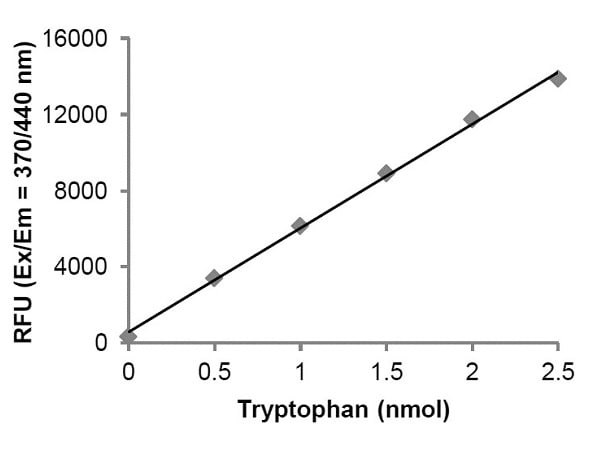Tryptophan Assay Kit (Fluorometric) (ab211098)
Key features and details
- Assay type: Quantitative
- Detection method: Fluorescent
- Platform: Microplate reader
- Sample type: Serum, Urine
- Sensitivity: 2.5 µM
Overview
-
Product name
Tryptophan Assay Kit (Fluorometric) -
Detection method
Fluorescent -
Sample type
Urine, Serum -
Assay type
Quantitative -
Sensitivity
2.5 µM -
Species reactivity
Reacts with: Mammals, Other species -
Product overview
Tryptophan Assay Kit (Fluorometric) (ab211098) provides a convenient method to quantify tryptophan present in serum and urine. The assay can detect bound tryptophan in urine and free and bound tryptophan in serum. The assay principle is based on a non-enzymatic reaction that uses tryptophan as a building block, producing an intermediate product that reacts with a catalyst in order to generate a fluorophore that can be detected at Ex/Em = 370/440 nm.
The reaction is specific for Tryptophan and other amino acids do not interfere with the assay. The assay can detect as little as 2.5 µM of tryptophan in a variety of biological samples.
-
Notes
Tryptophan (TRP, W) is one of the eight essential amino acids, and is mainly used for protein synthesis. Additionally, Tryptophan serves as a building block for several metabolites including kynurenine, serotonin, tryptamine, melatonin, niacin, and NAD/NAPD. Tryptophan is the only amino acid that can be found in blood in two forms: bound (BTRP) and free (FTRP) Tryptophan. Changes in tryptophan concentrations are directly related to a number of physiological and behavioral processes including: sleep, memory, depression, motion sickness, bipolar disorders, and schizophrenia. In general, tryptophan is the least abundant amino acid in humans. External sources of tryptophan include chicken, tuna, bananas, cheese, chocolate etc. Chemically, tryptophan side chain (indole) confers its unique fluorometric properties.
-
Platform
Microplate reader
Properties
-
Storage instructions
Store at +4°C. Please refer to protocols. -
Components 100 tests TRP Deproteinization Reagent 1 x 3ml TRP Neutralization Solution 1 x 4ml TRP Condenser 1 x 2ml TRP Catalyst 1 x 2ml TRP Standard (25 mM) 1 x 0.1ml -
Research areas
-
Relevance
Reactive nitrogen species (RNS) are formed continuously in vivo but their concentration in the body rises notably during inflammation and several pathophysiological conditions. RNS are responsible for both nitration and oxidation of several physiological targets, in particular the amino acid residues of proteins. -
Alternative names
- Tryptophan
Images
-
Typical Tryptophan standard calibration curve.
-
Estimation of Tryptophan in human urine and serum (TTRP, total, and FTRP, free). To measure TTRP and FTRP levels in serum, samples were deproteinized using the kit protocol. Serum total Tryptophan (10 µL, undiluted), serum free Tryptophan (30 µL, undiluted), and urine (25 µL, 10-fold diluted). Samples were assayed following the kit protocol. Estimated concentrations of Tryptophan: total Tryptophan in serum: 44.2 µM; free Tryptophan in serum: 13.7 µM; bound Tryptophan in serum: 30.5 µM; Total Tryptophan in urine: 32.6 µM.







